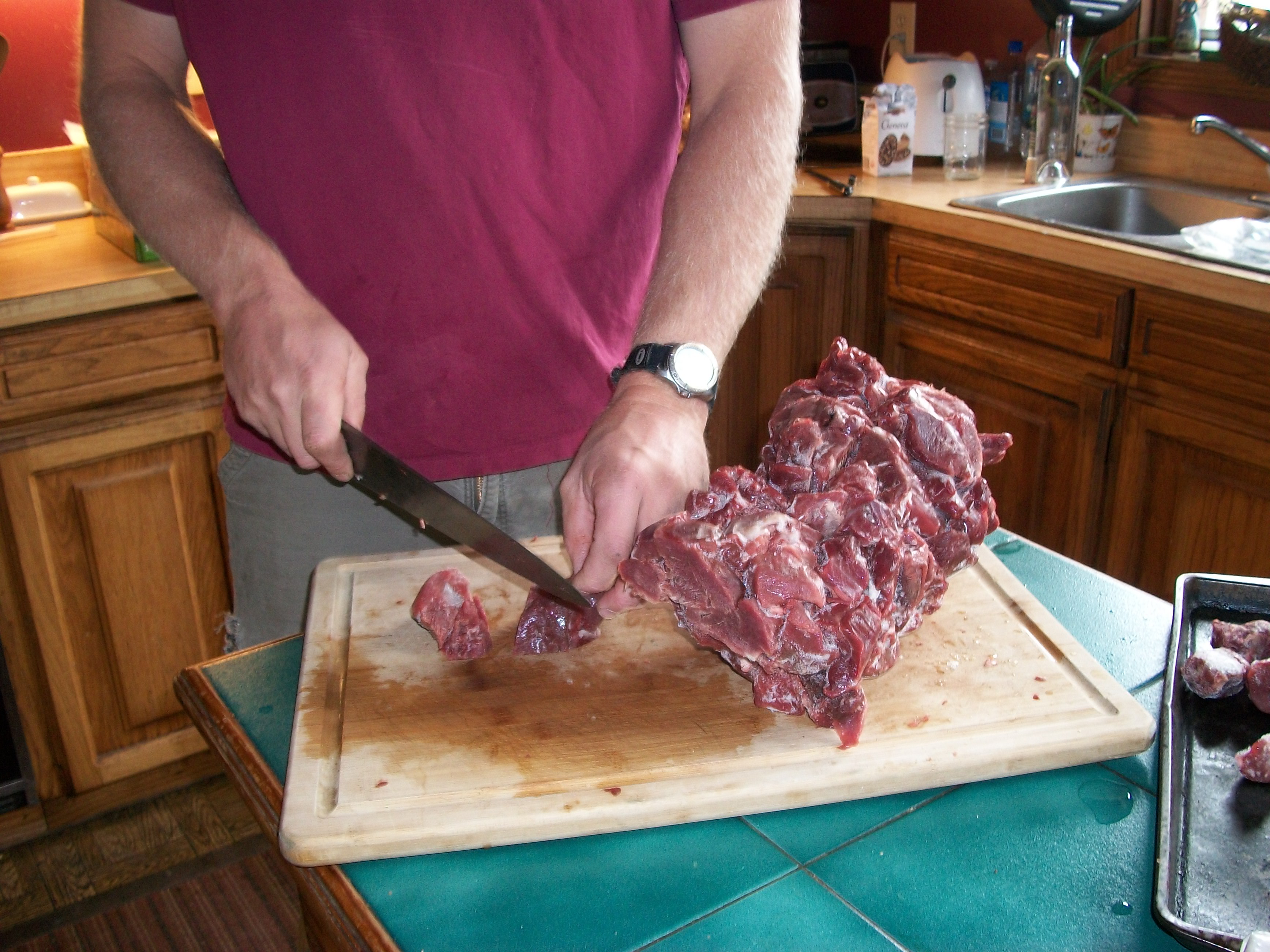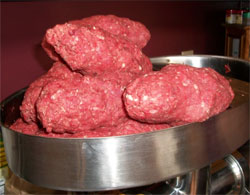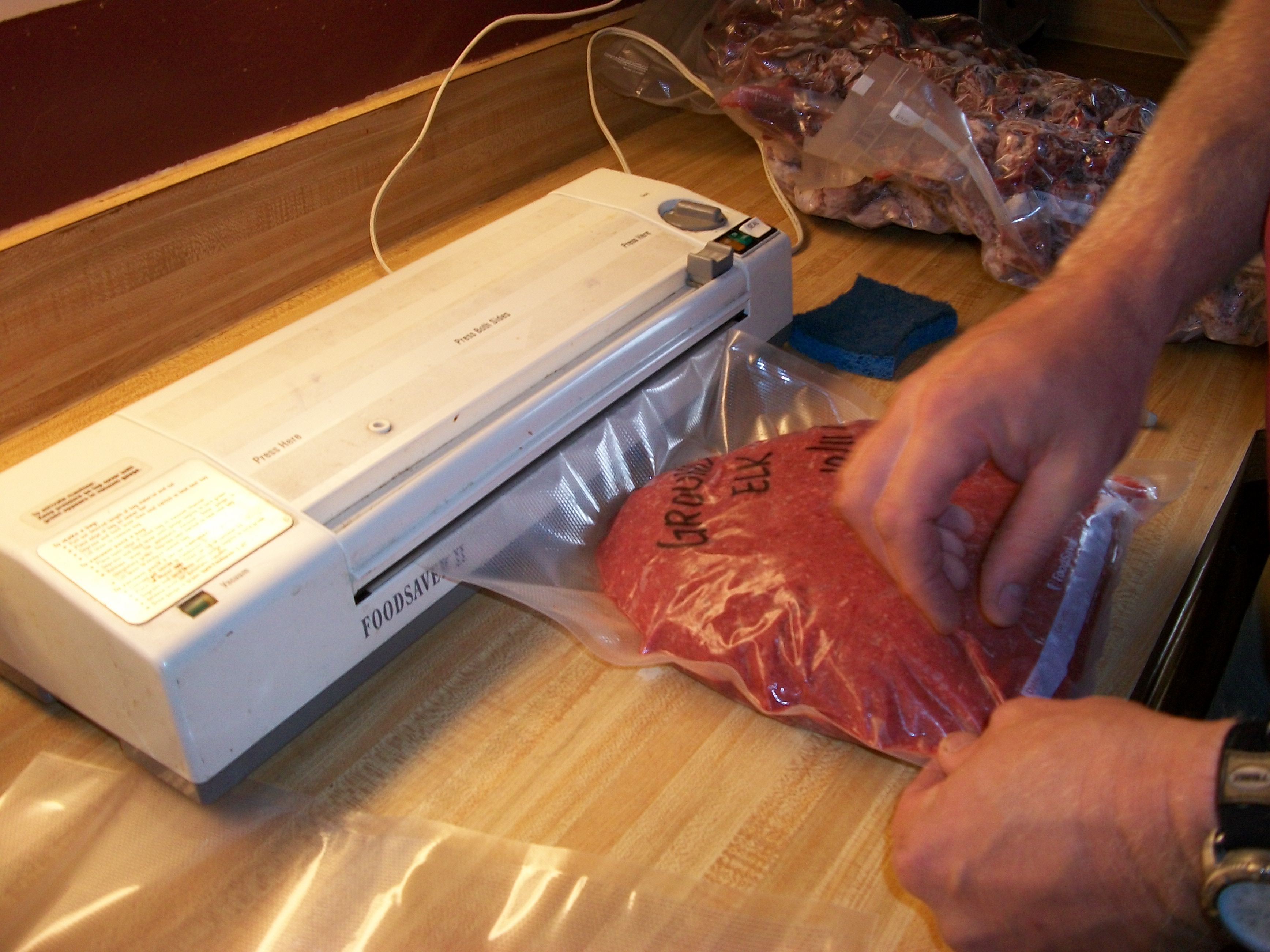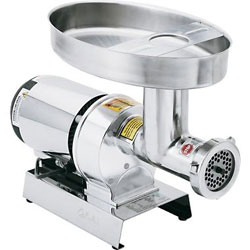A lot of people take their animals down to a local meat processor, if not for the whole animal, at least for grinding the scraps and less tender pieces of meat, and for making sausage and jerky and such. If you are a catchatarian, you might not want to do that because most meat processing plants do not just process wild game–they also process cows, pigs, etc. In addition, when they make jerky or sausage they are likely to use fat or other byproducts of those animals as well. You’ve gone so far as to kill your animal and process the major cuts of meat; why not go all the way and grind it yourself and make your own jerky, brats, and sausage?
 The first thing I learned about grinding meat, even small animals like grouse or pheasant, is that it is much easier to do if your meat is at least partially frozen. If you are processing a large animal like an elk, and want to also grind your meat that same day (which is a mighty ambitious undertaking!), make sure you start to freeze the scraps as soon as possible while you finish butchering the elk. Defrosted meat turns to mush almost the first time you send it through the grinder, and for the best ground meat (the second thing I learned), it is recommend that you send it through the grinder three times.
The first thing I learned about grinding meat, even small animals like grouse or pheasant, is that it is much easier to do if your meat is at least partially frozen. If you are processing a large animal like an elk, and want to also grind your meat that same day (which is a mighty ambitious undertaking!), make sure you start to freeze the scraps as soon as possible while you finish butchering the elk. Defrosted meat turns to mush almost the first time you send it through the grinder, and for the best ground meat (the second thing I learned), it is recommend that you send it through the grinder three times.
 My friend Barney has been doing this for a while now, and continues to learn new things every year. The first year, he didn’t freeze the meat, and he didn’t grind the meat three times. The result was that he actually ended up with some nicely ground meat, but when you chewed it you would encounter little pieces of sinew that you would end up having to spit out. It was a very strange combination, and though some people might not mind, one thing that turns people off of wild game is when it suddenly seems like a wild animal and not something you bought at the supermarket. The first time you put the meat through the grinder, it gets lighter in color, but it’s still dark enough that you can see little white flecks throughout; pieces of sinew. I know some people just try really hard to cut all that out before they grind the meat, but that’s really just a waste of meat.
My friend Barney has been doing this for a while now, and continues to learn new things every year. The first year, he didn’t freeze the meat, and he didn’t grind the meat three times. The result was that he actually ended up with some nicely ground meat, but when you chewed it you would encounter little pieces of sinew that you would end up having to spit out. It was a very strange combination, and though some people might not mind, one thing that turns people off of wild game is when it suddenly seems like a wild animal and not something you bought at the supermarket. The first time you put the meat through the grinder, it gets lighter in color, but it’s still dark enough that you can see little white flecks throughout; pieces of sinew. I know some people just try really hard to cut all that out before they grind the meat, but that’s really just a waste of meat.
 The second time you send the meat through, it gets lighter still and the white pieces are less distinguishable. You might think, “Oh, that’s good enough. I’ve got other things to do.” But if a thing’s worth doing; it’s worth doing well. You went to a lot of trouble to get this animal to this stage; you’re going to start skimping now? So send the meat through one more time, then package with a vacuum sealer in amounts that will work best for you. If you are planning to make jerky, you will want some pretty big packages of ground meat, maybe 2-3 pounds. Since I am usually just cooking for my husband and myself, I make mostly one pound packages. I don’t actually weigh it, but I have a soup ladle that just happens to make fairly consistent one pound scoops.
The second time you send the meat through, it gets lighter still and the white pieces are less distinguishable. You might think, “Oh, that’s good enough. I’ve got other things to do.” But if a thing’s worth doing; it’s worth doing well. You went to a lot of trouble to get this animal to this stage; you’re going to start skimping now? So send the meat through one more time, then package with a vacuum sealer in amounts that will work best for you. If you are planning to make jerky, you will want some pretty big packages of ground meat, maybe 2-3 pounds. Since I am usually just cooking for my husband and myself, I make mostly one pound packages. I don’t actually weigh it, but I have a soup ladle that just happens to make fairly consistent one pound scoops.
 The vacuum sealer is essential for wild game, especially elk since it is such a large animal that it should take you the better part of a year to eat it all. Freezer burn will wreck any meat, and if you just use freezer baggies, you will find the freezer burn creeps in almost right away. Another mantra of ours is don’t skimp on equipment. You took your hunter safety class, practiced at the shooting range, scouted your animal, finally made the kill, field dressed it, butchered it, and now you’re going to save ten dollars on a vacuum sealer? I have a food saver and buy both rolls of plastic and pre-made bags. The thing that will put the most wear and tear on your machine is sucking moisture into the electronics. Freezing the meat takes care of this problem for the most part, but you can also put a paper towl in the package to absorb some of the moisture as you seal it. Have you ever noticed that the chicken you buy at the grocery store has an absorbent towel on the bottom of the package?
The vacuum sealer is essential for wild game, especially elk since it is such a large animal that it should take you the better part of a year to eat it all. Freezer burn will wreck any meat, and if you just use freezer baggies, you will find the freezer burn creeps in almost right away. Another mantra of ours is don’t skimp on equipment. You took your hunter safety class, practiced at the shooting range, scouted your animal, finally made the kill, field dressed it, butchered it, and now you’re going to save ten dollars on a vacuum sealer? I have a food saver and buy both rolls of plastic and pre-made bags. The thing that will put the most wear and tear on your machine is sucking moisture into the electronics. Freezing the meat takes care of this problem for the most part, but you can also put a paper towl in the package to absorb some of the moisture as you seal it. Have you ever noticed that the chicken you buy at the grocery store has an absorbent towel on the bottom of the package?
 You also don’t want to skimp on your grinder. Get as good a commercial grinder as you can afford. We are big fans of Cabelas, because their products have stood the test of time for us, and also because we live at least two hours from the kind of store that sells what we need. If you live in a metro area you might find Bass Pro Shops or another hunting and fishing superstore, or some other specialty store might have the equipment you need.
You also don’t want to skimp on your grinder. Get as good a commercial grinder as you can afford. We are big fans of Cabelas, because their products have stood the test of time for us, and also because we live at least two hours from the kind of store that sells what we need. If you live in a metro area you might find Bass Pro Shops or another hunting and fishing superstore, or some other specialty store might have the equipment you need.
To clean the grinder, first run bread through it. I’ve heard of using ice also, but the bread is better at getting all of the grease out of the machine. Clean all the parts by hand, dry everything thoroughly, and store everything securely. In Colorado we don’t have to worry much about moisture since it’s so dry here, but if you live in a humid area you might want to store the blades and other accessories in ziploc baggies filled with rice. We used to put rice in our salt shaker at the beach to keep the salt from all clumping together and clogging the holes. Rice is great for absorbing moisture.